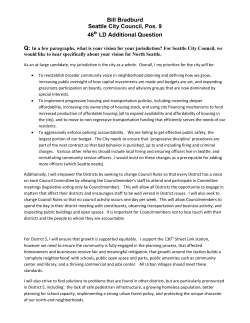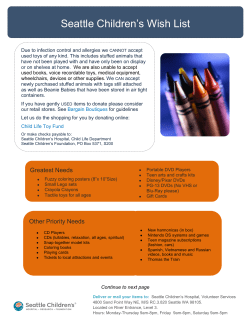
the Comment Letter here.
Monday, May 4, 2015 Mayor Murray and Seattle City Council PO Box 34025 Seattle, WA 98124‐4025 Re: Move Seattle Transportation Levy Dear Mayor Murray and Seattle City Councilmembers: The undersigned organizations represent a coalition working to ensure that the Move Seattle Transportation Levy makes the greatest possible contribution toward meeting our City’s wide-ranging and evolving transportation needs. Recognizing the importance of all modes of transportation, including transit, bicycling and walking, we are committed to ensuring that the transportation levy not only achieves our transportation goals, but also advances racial equity and reduces existing social and economic disparities. As a coalition, we believe an equitable city is one where safety, mobility and opportunity are not determined by race, income, age, ability, or neighborhood. Acknowledging historic underinvestment, transportation investments should prioritize projects that will eliminate existing and future disparities. A commitment to community-driven engagement will ensure expanded opportunity for all through an open, accessible and inclusive processes. Move Seattle must improve service for people who depend on public transportation—low-income communities, communities of color, immigrants and refugees, older adults, youth, and individuals with disabilities or other mobility limitations. Transportation is essential for creating true communities of opportunity, with far-reaching influence on the structure of cities, job creation and access, energy use and carbon emissions, housing stock, land use and environment, economic opportunity, community development, and health outcomes. Access to affordable and reliable transportation widens opportunity and is essential to addressing poverty, unemployment, and other equal opportunity goals such as access to good schools and health care services. The Seattle Race and Social Justice Initiative (RSJI) is a citywide effort to end institutionalized racism and race-based disparities in city government. We support and encourage its use comprehensively and consistently when evaluating and implementing projects. A safe, affordable, and convenient system promises to increase transportation options for all residents; however, historic investments have not fairly distributed benefits to all communities and populations. Too often the burden of transportation decisions have long-lasting effects on particular neighborhoods and are compounded by other social, economic, cultural, and environmental factors. By leveraging complementary policies, these barriers can be overcome to expand prosperity, affordability, and livability throughout Seattle. We believe the Transportation Levy can and should be implemented in a way that eliminates these disparities. We appreciate the inclusion of equity in the proposal and will continue to support those elements as well as work to expand the proposal’s ability to improve opportunity in our communities. The Transportation Levy can assist the City in becoming more equitable in many ways, including: Building to Vision Zero standards. In order to reach Vision Zero by 2030, projects will need to be prioritized based on their ability to improve safety and every project -- especially every major capital project -- needs to be designed to achieve zero deaths and serious injuries, not just "improve" safety conditions. Taking an equitable approach to engagement. a) Engage community members where they gather, i.e. community centers, centers of worship, etc.; b) spend the greatest time in areas at risk of displacement and incorporate into the plan what the community already knows about what they need in their neighborhood with regard to safety, accessibility, connectivity, etc.; and c) consider contracting with community-based organizations and trusted leaders to gain access to the community. Making the non-work trip as easy as the work trip. Improve access to parks, cultural centers, grocery stores, schools, and other key community destinations. Improving areas with lower performance. Improve citywide metrics and health outcomes overall while reducing disparities between neighborhoods. Leveraging complementary policies to maximize opportunity. Transportation investments are most effective when coupled with a concurrent focus on Frequent Transit Network corridors, affordable housing, school performance, parks development, business support and other complementary policy areas. Leveraging complementary policies to reduce displacement. Transportation investments not only increase access and opportunity for those living in proximity, it also makes the neighborhood more desirable and can increase risk of displacement. For low-income communities, persons of color, renters and other groups, this risk of displacement needs to be mitigated with complementary policies and investments that empower them to remain in their neighborhood and benefit from these improvements. Engaging often, experimenting and learning. A corridor approach to infrastructure development allows more tailored community-driven approaches to each corridor identified. Community engagement throughout the corridor design and implementation phases allows community priorities to be heard and incorporated into projects while still implementing modal plans. Putting communities to work. Increase priority hire policy and extend its application to projects below the current contract threshold. Taking advantage of past/ongoing investments. Expand connectivity to existing infrastructure to promote increased access to transportation system. Enhance transportation using supportive land use policies and infrastructure dollars to further placemaking efforts, especially around large capital investments like high capacity transit. Preparing for and accommodating growth. Prioritize transportation investments in areas targeted for growth, including urban centers and villages, major institutions, and employment centers. Balance investments which mitigate existing disparities in level of service with investments targeting high growth areas. We look forward to continuing to work with the Mayor’s office, City Council and the public to move Seattle forward equitably, safely, and together. Please see attached for an early set of considerations to advance equity to be included in the transportation levy. Sincerely, Cascade Bicycle Club Feet First Futurewise One America Puget Sound Sage Seattle Neighborhood Greenways Transportation Choices Washington Bikes The following table outlines projects that further the principles discussed in the attached letter. These initial projects listed are not exhaustive, but do reflect stated community goals. We will continue to communicate with the Mayor’s office and City Council as we finalize our recommendation. Table 1. Considerations to move Seattle forward Equity Project Description Graham St. Station Future station development, planning & design. Accessible Mt. Baker Planning & Design development. Move Seattle for Kids Add to existing “Safe Routes to touch every School” to enhance safe walking routes to high need schools. Corridor Safety Projects This is a key program that addresses traffic violence. Enhanced Outreach Provide non-traditional outreach opportunities on major maintenance and large capital projects. Outreach within traditional community groups that includes translation services. Equitable Implementation of the Bicycle Master Plan As directed by the 2014 Bicycle Master Plan, target safety improvements to the seven priority census tracts. Equitable Implementation of the Pedestrian Master Plan Continue to include an equity lens in the 2015 Pedestrian Master Plan update Bundled Priority Hire Develop a program for targeted bundling to cross $5 million threshold for priority hire projects. Bundling projects also can result in cost savings by installing multiple curb ramps, street trees, and bike lanes at one time.
© Copyright 2025










